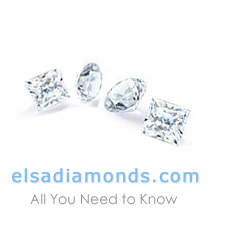
Value of Diamonds
Diamond Cutting And The Effect On Value
Rough diamonds come in several basic shapes. The most common shape is in the form known as an octahedron. The octahedron resembles two Egyptian pyramids placed base to base, that is the usual crystal form of a diamond. A rough diamond is rarely found in the perfect octahedral shape. Another rough shape found, especially in Brazil, is the cube. Often times the rough diamonds shape is a bit distorted, or have lost edges or edges have failed to develop.
Diamond cutters will have to deal with very irregular shapes at times
The history of improving the appearance of the rough diamond is exceedingly interesting. The earlier facetted stones were usually very similar in shape to the rough piece from which they came. In the past only when a defect had to be covered up did the cutter apply lots of facets.
Diamond cutting methods are still the same
The methods of the diamond cutter has not changed much over the years, but the shape of the finished product has. The ancient rubbing together of stones by hand is very rarely done. Another way to diamond cut is by attaching one of the stones in wax as a handle, while the other is rotated at a moderate speed in a specially constructed lathe type machine. The facets are sometimes polished in the same manner.
The object of the slow laborious process of cutting and polishing the rough stones is to obtain as much of a total reflection of light as possible, used to dazzle the beholder. A very popular cut is the round brilliant. The brilliant serves to refract and reflect the light that falls upon it, which also takes place dispersion of white light into prismatic colors. Rarely does a cut reduce the carat weight of the stone more then fifty per cent.
What form Diamond
There is no definite form which will totally reflect light falling upon it from every direction equally. From trial and error and experience, cutters make shapes that give maximum possible effect for light that enters the stone from the front. Cutting the stone only a few degrees different from the angles of the ideal shape, results in a decrease or increase of the brilliancy of the stone, and hence the value.
To obtain total reflection of light within the brilliant, the back of the stone must be cut so that no considerable amount of light should strike it more steeply than 24 degrees from a perpendicular to the surface at the point where the light strikes. Anybody with knowledge in geometry and trigonometry can calculate what angle the back should have, after an angle has been chosen for the top. Some good angles for a diamond are 35 degrees for the top and 41 degrees for the back. Angles cut more or less will most likely lead to less light being reflected, equaling a far less brilliant piece.
The market is full of poorly cut stones
Although poorly cut stones are less brilliant than well cut stones, the market is full of lumpy stones. There are many reasons for these so called lumpy stones. Diamonds are sold by weight and have been going up in price over the years. Anything that will allow a dealer to quote a lower price per carat makes sales easier. A smaller nicer diamond will cost more per carat than a larger less finished one. Not only will a larger stone weigh more, but it will also be less labor intensive. To the average buyer, price per carat is what is compared, so it makes sense for dealers to carry some large lumpy stones.

 Some time ago you both made a promise. A promise to each other. Now it’s time to recognise that you both meant that promise, and that now you both still mean it.
Some time ago you both made a promise. A promise to each other. Now it’s time to recognise that you both meant that promise, and that now you both still mean it.